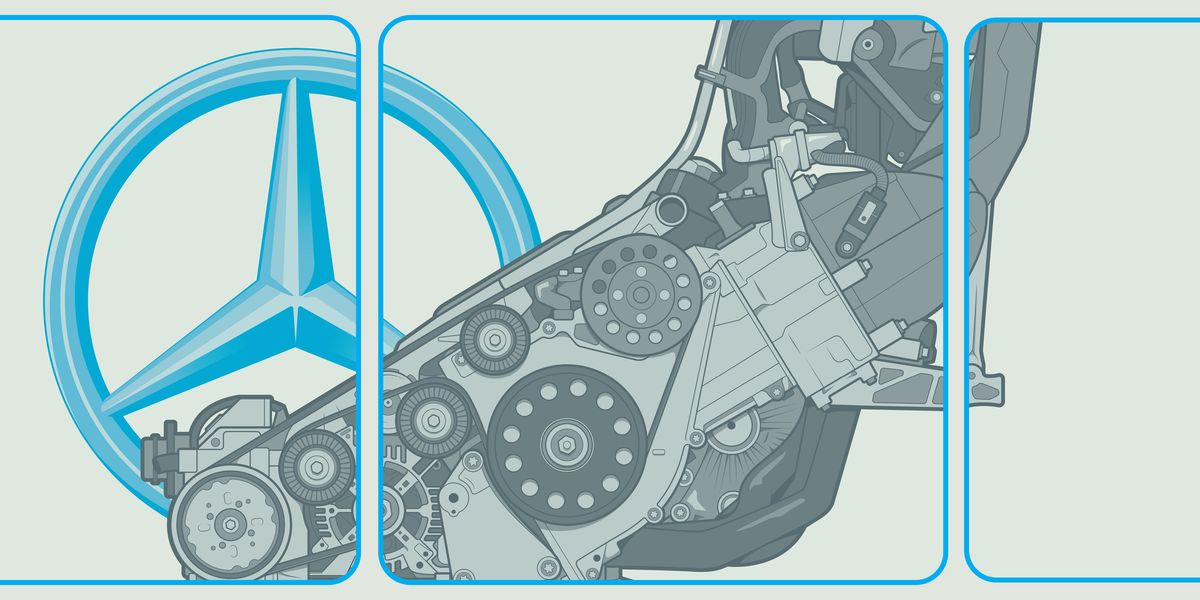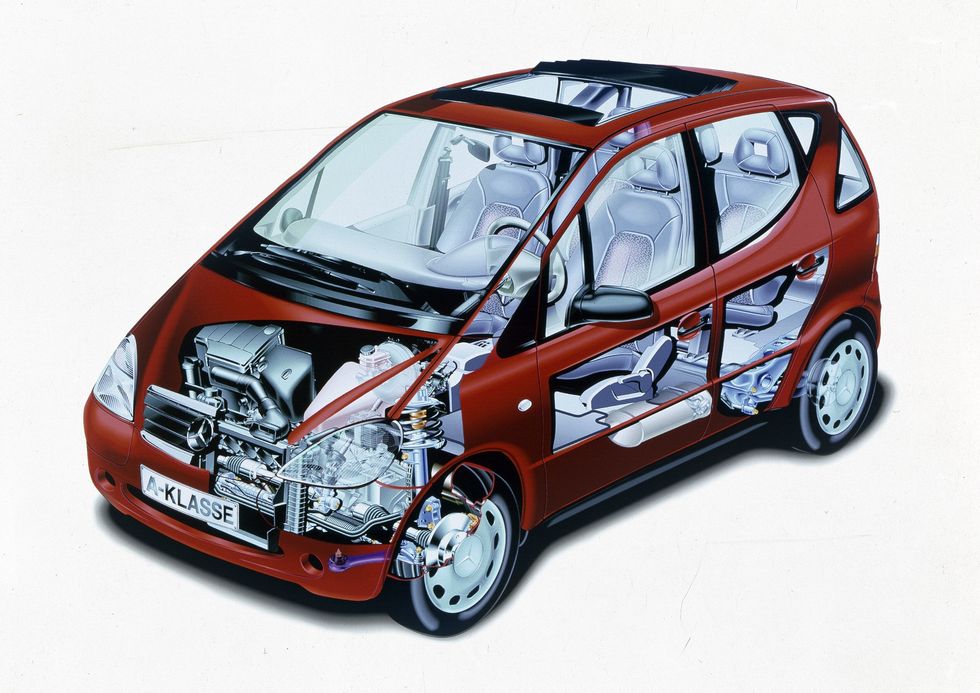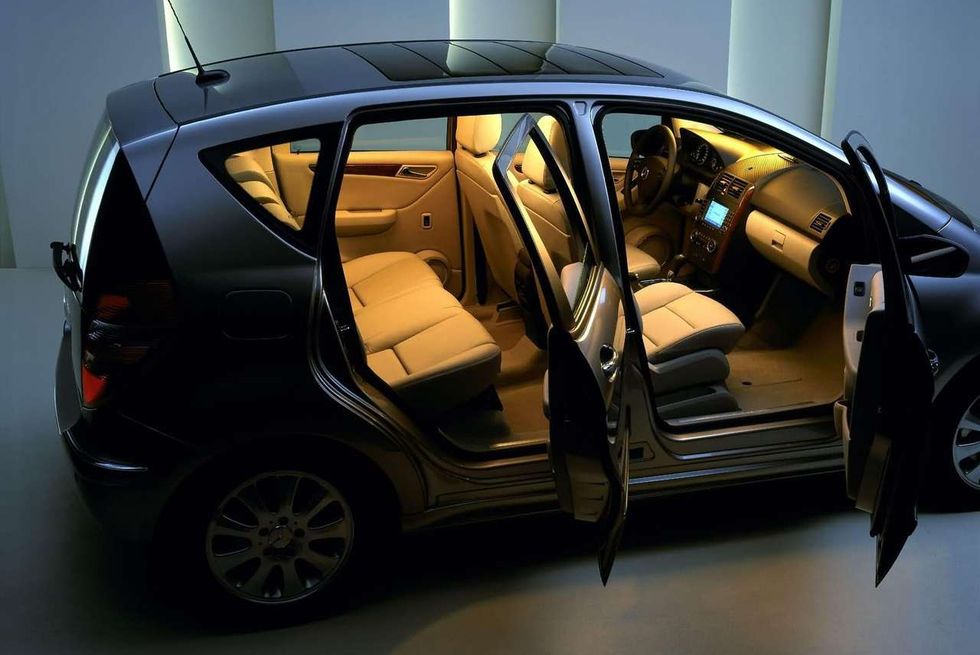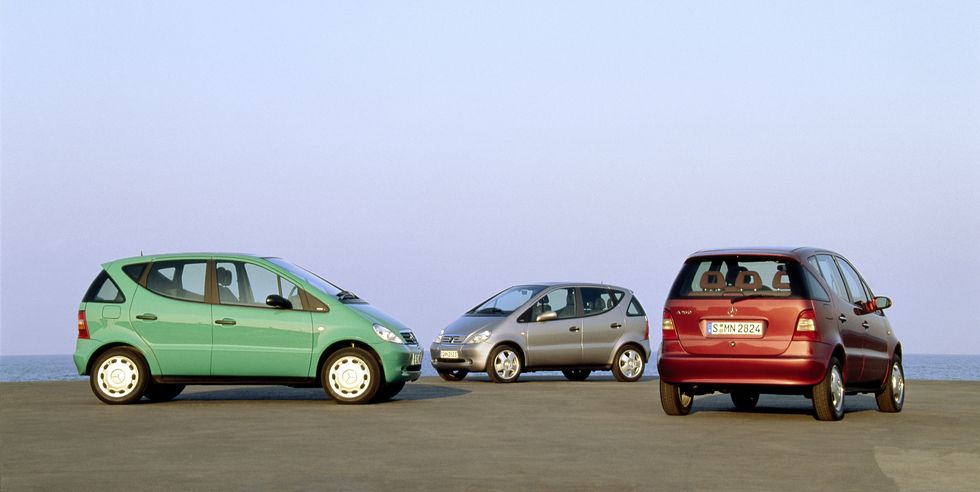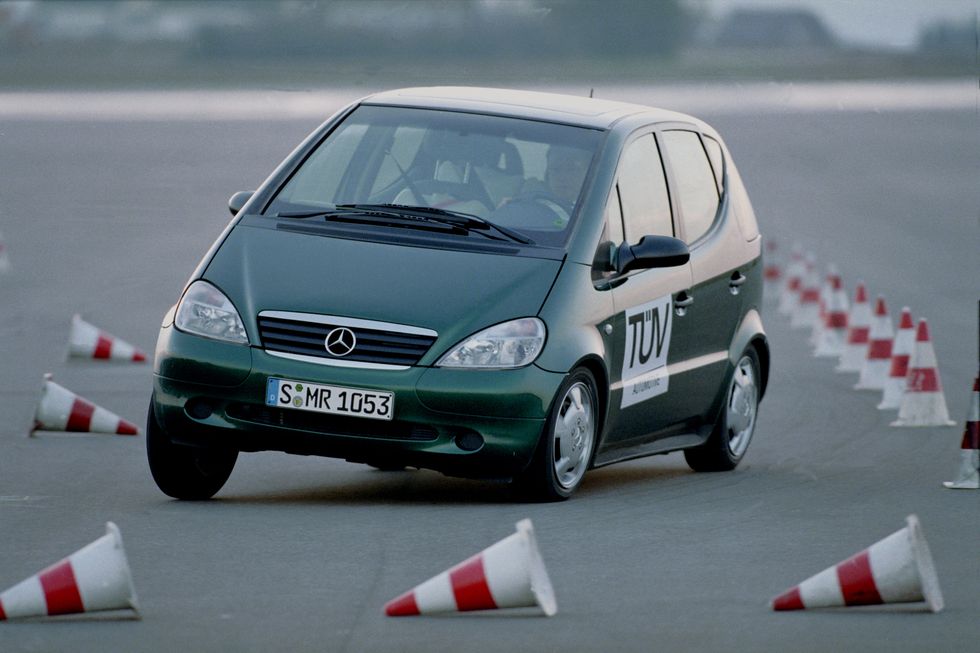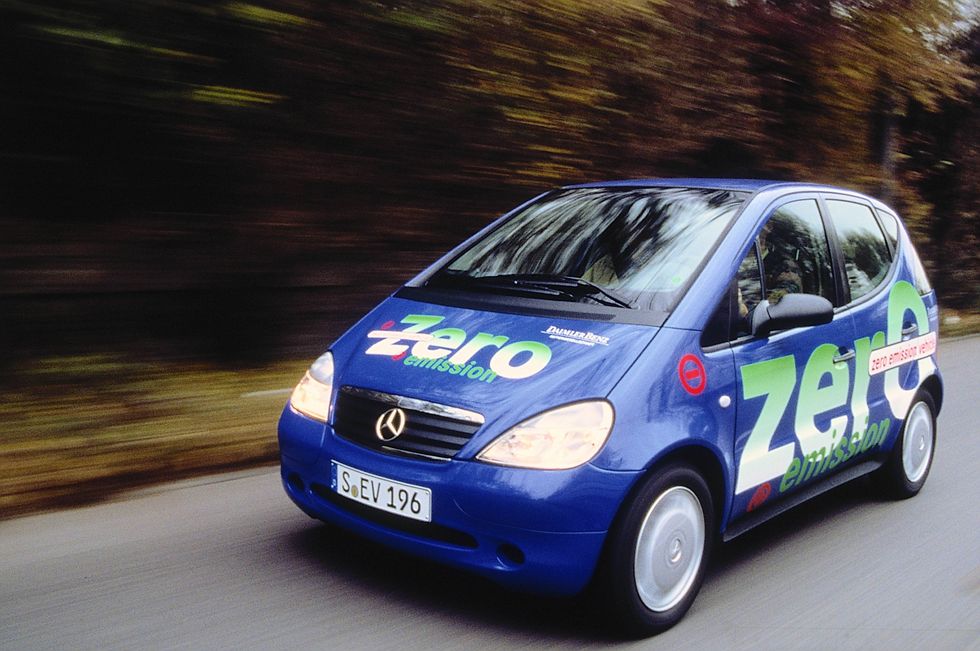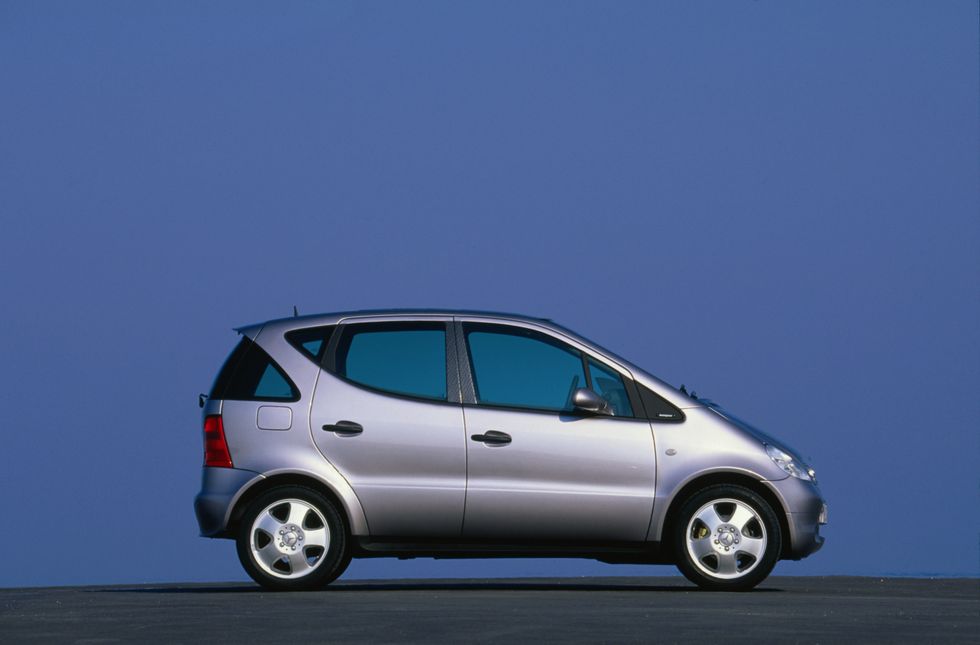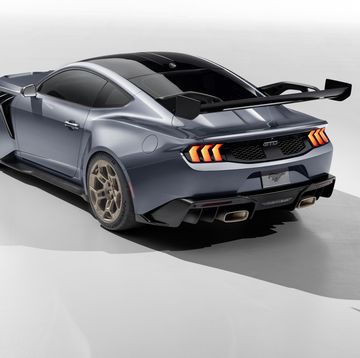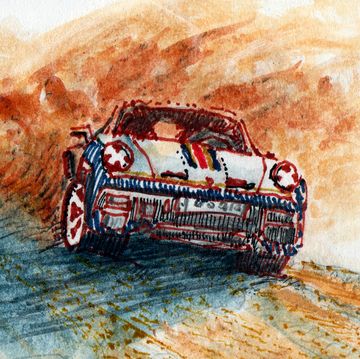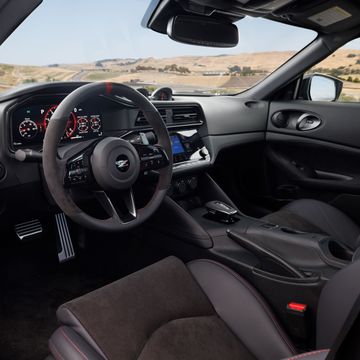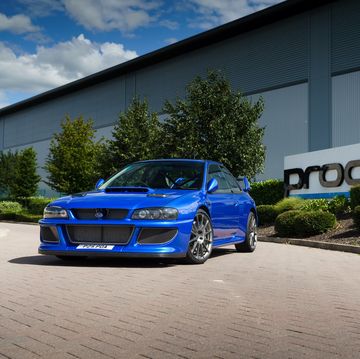We as a people have known for a while that when space is limited, you've got to build up, not out. It's the basic tenet on which cities are formed. It was also the design brief behind the first Mercedes-Benz A-Class. In the Nineties, there was a push for smaller, more intelligently designed cars. Global population had grown rapidly since the Fifties, and cities were getting increasingly dense. Mercedes wanted to present a solution to the problem, and did so with a car that was unlike anything it had made before, or since.
The idea for the first compact, front-wheel drive Mercedes was to offer C-Class-esque interior space on a significantly shorter footprint. The A-Class also had to be as safe as an E-Class, and this required a very different approach to packaging and one of the weirdest engines we've ever seen in a car.
On its own, the M266 engine isn't too interesting by Mercedes' vaunted standards. An all-aluminum, single-cam, two-valve gas-powered four-cylinder made in displacements between 1.4 and 2.1 liters and, at most, 138 horsepower, nor the 1.7-liter 89-hp OM668 turbodiesel. What is interesting is that both were canted forward at a 59-degree angle.
Now, a canted-forward engine was not a new thing when the A-Class debuted in 1997. Mercedes itself famously angled its big 3.0-liter six 30 degrees to fit under the low hood of the 300SL Gullwing in the Fifties, and the Chrysler slant-six sat at the same angle for its run from late-Fifties to turn of the millennium. Lancia also canted its Sixties/Seventies V-4 over at 45 degrees for similar reasons, but what was unique about the Mercedes A-Class engines were both the dramatic angle, and the fact that it was done in a transverse-engine platform.
In the A-Class, the occupants sat on a false floor about 8 inches taller than the actual floorpan. Mercedes called this the "sandwich" principle and the idea was to create lots of occupant space on a small footprint, without compromising crash safety. In the instance of a frontal impact, the engine and transmission were designed to slide along the pedal box and under the floorpan, protecting the passenger compartment without the need for a large crumple zone at the front. This, in theory, saved money, and weight, while allowing the A-Class to pass both European and U.S. crash tests. The A-Class had steel bars running lengthwise across the car to absorb much of the impact in a frontal collision, and it was thought that the car would perform well in side impacts because a conventional car's front bumper would hit the floorpan, not the false passenger floor.
As longtime R&T European editor Paul Frère noted in his October 1997 article on the new A-Class, this sandwich design produced a remarkable car. It was 22.8 inches shorter than the C-Class while offering about as much passenger/cargo room, and even the heaviest variant, the diesel, weighed just 2350 pounds. A diesel Golf weighed about 2600. Think of it this way—the A-Class was about 15 inches shorter than a Mazda Miata, weighed about the same, yet offered room for four plus trunk space.
A fan site for the A-Class says that the M166 and OM668 engines are generally robust, but their unique design makes servicing a problem. For example, replacing a starter motor requires dropping the engine from the car. The A/C compressor and alternator are also located at the very bottom and the oil filter housing is buried up by the firewall. From under the hood, fluid reservoirs and a dipstick are accessible, but not much else.
Maintenance issues aside, the A-Class still presented a very clever vision for the future of the car, but what made it unique also led to a scandal the likes of which Mercedes have never seen. It was big news globally. Swedish magazine Tekins Värld subjected an A-Class loaded with five passengers to a 37-mph double lane change simulating an avoidance maneuver for a moose jumping out into the road. The A-Class failed spectacularly, rolling over in the process and injuring a passenger. In a 2017 interview with Automotive News Europe, Jürgen Hubert, brand chief of Mercedes at the time, said "[t]he problem was rather a combination of the position of the center of gravity and the chassis adjustment in an extreme driving situation."
The so-called "Moose Test" is a standardized procedure made popular by the Swedish automotive industry. It's about as extreme a test as a car can be subjected to, and even now, many popular cars have trouble passing.
The A-Class was unusually tall given its length and width, and that made the center of gravity high. In the February 1998 issue of Road & Track Frère argued that the moose test was too extreme and posited that many tall vehicles, loaded with people and/or cargo, would exhibit similar behavior in extreme driving maneuvers like this. But Mercedes still took very decisive action. This news came just days after the market launch of the A-Class, and Mercedes immediately stopped production, only resuming three months later. The fix involved fitting all A-Class models with electronic stability control at great cost. The car passed the moose test after this, and Mercedes avoided permanently damaging its reputation, yet it added significantly to the already-dear cost of developing the A-Class.
The A-Class sold well initially, but over the years, it started getting beat out by the more conventional Audi A3 and BMW 1 Series. The car was also quite expensive to build and develop, especially the engine and transmission, which were unable to be shared with larger, conventionally packaged cars. The A3 shared most of its mechanical components with the Volkswagen Golf, Beetle, Jetta, Skoda Octavia, and Seat Leon, allowing the VW Group to amortize costs across many models. Compact cars have little room for profit margin as it is. It's a lot easier to make more money on a bigger car because customers expect to pay more for such vehicles, despite being made from largely the same components. Making money on the totally unique A-Class was extremely difficult.
The A-Class was also a play at a younger crowd, but the car ended up being more popular with older buyers, who liked the tall A-Class for its ease of ingress and egress. Automakers hardly ever want to chase older buyers because they're only going to be customers for so long. (Mercedes isn't alone here. Toyota's entire Scion brand was created to get a younger audience, for example.) The idea with cars like the A-Class is to sell cars to people in their 20s and 30s who will keep coming back to Mercedes for decades to come.
Mercedes stuck with the "sandwich" platform through 2011, using it for two generations of A-Class, the first-generation B-Class, and the Vaneo MPV. But it wasn't worth building an all-new version of this platform. Mercedes instead developed a conventional, transverse-engine front-drive architecture that underpins A-, B-, CLA-, GLA-, and GLB-Classes
The A-Class was perhaps too clever by half. But, while this general layout never became a standard, the false-floor concept had a lot more life in it. Mercedes used the A-Class as a testbed for various powertrains, including a fully electric setup. The car was called the Zero Emissions Battery Research Activity, or ZEBRA for short. No really. The ZEBRA battery system took advantage of the false floor, packaging the batteries between the false floor and the car's actual floorpan, with the motor up front under the A's tiny hood.
It's a remarkably similar design to basically every dedicated EV—i.e. one not sharing a platform with an internal-combustion car—on sale today. Generally, the batteries are integrated with the floorpan or mounted just above it, with a secondary floor for the passenger compartment above. It's tough to say if other automakers drew inspiration from the ZEBRA directly, because the car wasn't very heavily publicized.
The Nineties were a time of great innovation in car design. Technology proliferated, and automakers across the spectrum experimented with new ways of doing things. Mercedes, previously the most imperious of automakers not just making a compact, but making this compact shows just how much things were changing.
Consumers arguably weren't ready for such a big swing. Mercedes still makes an A-Class, but it's much more in the mold of the VW Golf. The original A's false floor proved to be influential, but the radical thinking behind the rest of the car never caught on, even if in a vacuum, it presents a more logical approach to packaging for today's cars. Mercedes, like every other automaker, is in the business of making money, not making cars. Even if those cars are brilliant in their own, quirky way.
A car enthusiast since childhood, Chris Perkins is Road & Track's engineering nerd and Porsche apologist. He joined the staff in 2016 and no one has figured out a way to fire him since. He street-parks a Porsche Boxster in Brooklyn, New York, much to the horror of everyone who sees the car, not least the author himself. He also insists he's not a convertible person, despite owning three.
